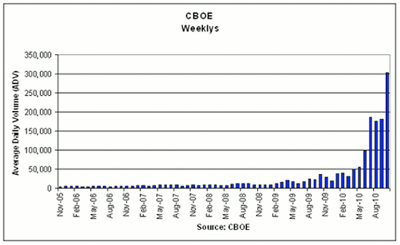In 1973, the Chicago Board Options Exchange (CBOE) introduced the standard call options that we know today. In 1977, put options were introduced. They have proven to be extremely popular as trading volume has grown at a compound annual growth rate over 25% between 1973 and 2009. Clearly, investors understand options, are becoming more comfortable with them, and are using them in a variety of strategies.
A New Class of Option
In 2005, 32 years after introducing the call option, the CBOE began a pilot program with weekly options. They behave like monthly options in every respect except that they only exist for eight days. They are introduced each Thursday and expire eight days later on Friday (with adjustments for holidays). Investors who have historically enjoyed 12 monthly expirations—the third Friday of each month—now can enjoy 52 expirations per year.
Investor interest in the weeklies has surged since 2009, with average daily volume at the end of 2010 exceeding 300,000 contracts. This can be seen in the figure below:

Click
to Enlarge
Source: Chicago Board Options Exchange (CBOE)
In fact, in the second half of 2010, the volume of the index weeklies increased to where they controlled between 5% and 7% of their underlying index volume at the time. Also in 2010, a popular trade emerged among retail account holders where they wrote covered calls using weeklies.
What Can You Trade with Weekly Options?
As of early 2011, the weeklies were available on 40 different underlying securities, including indexes and ETFs.
Indexes for the weeklies that are available include:
- CBOE Dow Jones Industrial Average Index (DJX)
- Nasdaq 100 Index (NDX)
- S&P 100 Index (OEX)
- S&P 500 Index (SPX)
Popular ETFs for which weeklies are available include:
- SPDR Gold Trust ETF (GLD)
- iShares MSCI Emerging Markets Index ETF (EEM)
- iShares Russell 2000 Index Fund (IWM)
- PowerShares QQQ (QQQQ)
- SPDR S&P 500 ETF (SPY)
- Financial Select Sector SPDR ETF (XLF)
Many popular stocks also have weeklies available. Given the investor interest in weeklies, it is very likely the CBOE will be adding even more securities. (You can find a complete list of available weekly options here.)
NEXT: Weekly Option Strategies, Plus Key Pros and Cons
|pagebreak|Weekly Option Strategies
So what strategies can you implement with weekly options? Well, just about any strategy you do with the longer-dated options, except now you can do it four times each month.
For premium sellers who like to take advantage of the rapidly accelerating time-decay curve in an option's final week of life, the weeklies are bonanzas. Now you can get paid 52 times per year instead of 12. Whether you enjoy selling naked puts and calls, covered calls, spreads, condors, or any other type, they all work with weeklies like they do with the monthlies, just on a shorter timeline.
The Short-Term Advantage of Weekly Options
In addition, during three out of four weeks, the weeklies offer something you can't accomplish with the monthlies: The ability to make a very short-term bet on a particular news item or anticipated sudden price movement. Let's imagine it's the first week of the month and you expect XYZ stock to move because the company’s earnings report is due out this week. While it would be possible to buy or sell the XYZ monthlies to capitalize on your theory, you would be risking three weeks of premium in the event that you're wrong and XYZ moves against you. With the weeklies, you only have to risk one week's worth of premium. This will potentially save you money if you are wrong, or give you a nice return if you are correct.
Although the open interest and the volume of the weeklies are large enough to produce reasonable bid-ask spreads, the open interest and volume are usually not as high as the monthly expirations. The well-known pinning action that takes place in monthlies—whereby a stock tends to gravitate toward a strike price on expiration day—does not seem to happen as much or as strongly with the weeklies. Perhaps that will change as more institutions enter the weekly market. (Understanding the real forces that move price is part of being a good trader.)
The Downside of Weekly Options
There are a couple of negatives regarding weeklies:
- Because of their short duration and rapid time decay, you rarely have time to repair a trade that has moved against you by either adjusting the strikes or just waiting for some kind of mean revision in the underlying security
- Although the open interest and volume are good, that is not necessarily true for every strike in the weekly series. Some strikes will have very wide spreads, and that is not good for short-term strategies
The Bottom Line
The weeklies are another tool in your investing toolbox. Like most of the other tools in that box, they are powerful enough to create quick profits or quick losses, depending on how you use them. The good news is that if you trade monthly options at all, then you already have some experience with the weeklies, because the final week of a month is nearly identical to how a weekly option behaves. Indeed, during the monthly expiration week, they are the same security. Anyone who has developed an expiration day (or expiration week) strategy is almost certainly using their strategy with the weeklies now. These same investors are no doubt eager for additional symbols to be added to the weekly lineup.
By Mike Scanlon, Born to Sell Blog





















